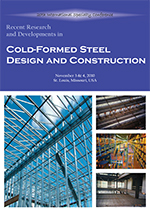Session Dates
03 Nov 2010
Keywords and Phrases
built-up section||modified slenderness ratio||axial strength
Abstract
According to section D1.2 of AISI S100-2007 for compression members composed of two sections in contact whose buckling mode involves shear forces in the connectors, a reduction must be made, KL r ⁄ must be replaced by ሺ KL r ⁄ሻ ୫ . This new modified slenderness ratio takes into account the connection weld spacing and the minimum radius of gyration of an individual shape in the built-up member. Under the provisions of section D1.2 a reduction in load capacity must be made for built-up welded box members, which are the subject of this study. An experimental investigation on 48 samples was done addressed to determine the comparative behavior under compression load of box sections composed of two C-section members in contact by seam welds with different weld spacings. The weld spacings in connections in the samples are 100 mm, 300 mm, 600 mm and 900 mm. The first set of 24 studs was tested under a rigid end support condition and the second set of 24 studs was tested using a flexible end support. The length of the samples was 900 mm with a cross-section of 100 mm x 100 mm. This configuration to form box members is widely used for columns or beams as frame and truss members. The base material thickness was 1.5 mm (gauge 16) for 24 samples and 2.0 mm (gauge 14) for the rest. The weld seams were 50 mm long in all cases except on the member ends; where they were 25 mm long. The testing done on the samples did not show a statistical reduction in the ultimate compression load capacity for these members except with a weld spacing of 900 mm and a flexible end support condition. The results of the investigation showed the reduction considered in section D1.2 section of AISI S100-2007 not applicable to determine the ultimate load cpacity for the rest of the members
Department(s)
Civil, Architectural and Environmental Engineering
Research Center/Lab(s)
Wei-Wen Yu Center for Cold-Formed Steel Structures
Meeting Name
20th International Specialty Conference on Cold-Formed Steel Structures
Publisher
Missouri University of Science and Technology
Document Version
Final Version
Rights
© 2010 Missouri University of Science and Technology, All rights reserved.
Document Type
Article - Conference proceedings
File Type
text
Language
English
Recommended Citation
Reyes, W. and Guzman, F. A., "Comparative Behavior of Built-up Cold-formed Box Sections under Rigid and Flexible End Support Conditions" (2010). CCFSS Proceedings of International Specialty Conference on Cold-Formed Steel Structures (1971 - 2018). 1.
https://scholarsmine.mst.edu/isccss/20iccfss/20iccfss-session3/1
Comparative Behavior of Built-up Cold-formed Box Sections under Rigid and Flexible End Support Conditions
According to section D1.2 of AISI S100-2007 for compression members composed of two sections in contact whose buckling mode involves shear forces in the connectors, a reduction must be made, KL r ⁄ must be replaced by ሺ KL r ⁄ሻ ୫ . This new modified slenderness ratio takes into account the connection weld spacing and the minimum radius of gyration of an individual shape in the built-up member. Under the provisions of section D1.2 a reduction in load capacity must be made for built-up welded box members, which are the subject of this study. An experimental investigation on 48 samples was done addressed to determine the comparative behavior under compression load of box sections composed of two C-section members in contact by seam welds with different weld spacings. The weld spacings in connections in the samples are 100 mm, 300 mm, 600 mm and 900 mm. The first set of 24 studs was tested under a rigid end support condition and the second set of 24 studs was tested using a flexible end support. The length of the samples was 900 mm with a cross-section of 100 mm x 100 mm. This configuration to form box members is widely used for columns or beams as frame and truss members. The base material thickness was 1.5 mm (gauge 16) for 24 samples and 2.0 mm (gauge 14) for the rest. The weld seams were 50 mm long in all cases except on the member ends; where they were 25 mm long. The testing done on the samples did not show a statistical reduction in the ultimate compression load capacity for these members except with a weld spacing of 900 mm and a flexible end support condition. The results of the investigation showed the reduction considered in section D1.2 section of AISI S100-2007 not applicable to determine the ultimate load cpacity for the rest of the members



